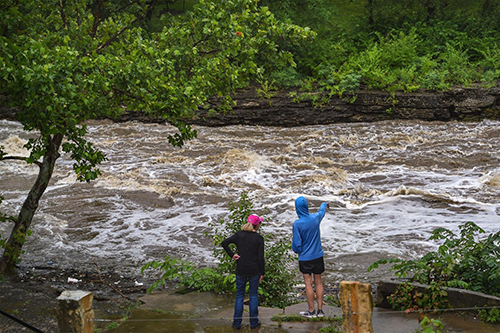Some digital resources may be temporarily unavailable due to maintenance.
“What’s your KC Q” is a joint project of the Kansas City Public Library and The Kansas City Star. Readers submit questions, the public votes on which questions to answer, and our team of librarians and reporters dig deep to uncover the answers.
Have a question you want to ask? Submit it now »
by Maxwell Adler
When it rains, it pours. And when it rains in Kansas City, you can bet that it will flood.
It’s not just your perception. Our temperatures are rising and we’re seeing more precipitation than in the past. More rain means more floods. Today, there are more than 15,000 properties at risk of flooding in Kansas City, according to FloodFactor, a tool that helps Americans evaluate the risk of flooding in their neighborhoods.
From the Great Flood of 1951, to the recent flash flooding on Interstates 35 and 70, Kansas Citians have been grappling with how to mitigate damage from summer storms for decades.
Prompted by our water-logged summer, Kansas City Star reader Bill Taft asked KCQ:
“When Kay Barnes was mayor, she started the 10,000 Rain Garden initiative to help prevent flooding. How did it work? Is it still going on?”
Good memory! The 10,000 Rain Garden Initiative launched in 2005 while Kay Barnes was mayor. The initiative, designed by a group of environmental infrastructure experts, was billed as a creative solution to some of Kansas City’s wet-weather problems.

Watts Mill Shopping Center on Wednesday, June 30, in Kansas City. | Tammy Ljungblad/The Star
What is a Rain Garden?
Rain gardens are shallow depressions with an abundance of native plants that are designed to catch and absorb stormwater runoff. These gardens can mitigate flash flooding events and decrease water pollution by soaking up and filtering stormwater runoff. By keeping excess rainwater out of our sewer system, rain gardens also help in reducing maintenance costs for the city and property owners.
With all of these benefits in mind, infrastructure experts pitched city leaders the following idea: plant 10,000 rain gardens in Kansas City.
The initiative’s primary goal was pretty straightforward: Install thousands of natural water filtration and absorption systems, like rain gardens, in order to soak up storm runoff and filter out pollutants without the help of the city’s low-energy efficiency water-treatment plants — which are frequently overwhelmed during large storms.
“It’s not lost on me that water treatment is one of the biggest users of energy in any of the government operations that we have in our metro region,” said Mike Kelly, a board member at Kansas City Climate Action.
The 10,000 rain gardens initiative was a public-private partnership, involving citizens, corporations, educators, nonprofit organizations, and local government agencies like the Kansas City water department.
One of the leaders behind the initiative was Lynn Hinkle. As the founder of ASTRA Communications and Goin’ Green, Hinkle has spent much of her career encouraging citizens to take an active role in their own communities. She spearheaded the rain garden initiative alongside other leaders of the green buildings and green infrastructure movement.
“I think anytime you educate people about what they can actually do to make a difference, you see people become a part of the solution,” Hinkle said of the effort.
Hinkle and her team of green infrastructure experts and environmentalists modeled the Kansas City initiative after similar programs in Oregon and Minnesota.
In the program’s first two years, Hinkle’s group estimated that information about the program reached more than 1 million people in 2006 and more than 3 million in 2007. And, by July 2008, 303 rain gardens had been officially registered.
Shortly after Mayor Barnes left office in 2007, progress on the initiative stalled. The program is no longer in existence, but the Kansas City Water department has taken over the maintenance of publicly owned rain gardens around the city.
One of the rain garden initiative’s shortcomings was its reliance on private development, said Tom Jacobs, the director of Environmental Programs at Mid-America Regional Council.
Kansas City has now shifted focus towards installing larger, public green infrastructure projects, as opposed to smaller, private projects that came out of the 2006 initiative.
“The city’s plans are now really focused more on things that they can do in terms of their own infrastructure investments,” Jacobs said.
One such city-led project is in the West Bottoms. It features new infiltration systems, drains, permeable paved streets and an interactive boardwalk system that invites the public to appreciate the area’s native plants and rain gardens.
As of 2020, there were more than 230 green infrastructure sites in Kansas City. This year, Kansas City signed an agreement with the EPA to install an additional 480 green acres by 2040.
Kansas City is part of a pioneering green infrastructure experiment. The city’s hypothesis is that it’s cheaper to capture rainwater on the surface — using natural systems — than it would be to build more pipes underground.
“Green infrastructure is such an important component of what we need to do,” Kelly said. “Whether it be health, energy, watershed, emissions, cost savings, all of those things, green infrastructure touches on it.
Despite falling short of its official goal of building 10,000 water gardens in Kansas City, the outward facing, public messaging component of the initiative was successful, Hinkle said.
“I don’t think to this day, we really know how many rain gardens were created as a result of it, but I know that it helped the public understand the problem,” Hinkle said.
Submit a Question
Do you want to ask a question for a future voting round? Kansas City Star reporters and Kansas City Public Library researchers will investigate the question and explain how we got the answer. Enter it below to get started.
